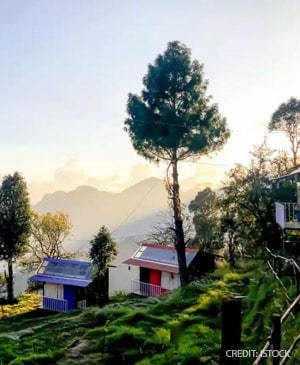Birding In Andaman & Nicobar Islands
A birding tour of the Andaman and Nicobar Islands is an object lesson in avifauna evolution for any curious birder or student of Darwin.
For it is here, on this cluster of islands hundreds of miles off the east coast of mainland India, that one gets to find as many as 21 endemic species of birds. That is more number of endemics than any particular birding hotspot in mainland India can boast (with the possible exception of the Western Ghats, if you count in the recent ‘splits’). The incredulity of this number hits home when you consider that the land mass of the Andaman and Nicobar Islands is a mere fraction of the wide swathes of birding areas in India.
So what explains this evolutionary avifauna bounty in the Andamans?
Geography – is the short answer. Picture this: an archipelago of 572 islands in the southeast of the Bay of Bengal, isolated from any mainland by hundreds of miles of sea in all directions. Such is the splendid isolation of this archipelago that the tribal community on one particular island, named the Sentinel Island, still lives in the hunting and gathering Palaeolithic age and is violently unwelcoming of any outsiders.
This geographical isolation has proved a valuable boon for the birds of the Andaman and Nicobar Islands. With no nearby land masses to fly to, many species of birds have remained exclusive to these islands. Today, these endemic birds of Andaman and Nicobar draw birders in droves from across the world every year. An Andaman birding tour is finding its rightful pride of place in the itinerary of anyone on the birding tour of India.
Most of the birding action is centred in the Andaman Islands in the north and middle of the archipelago. Port Blair, the capital of Andaman, is a developed area and the hub of tourism to the islands. From here, birders diverge in different directions towards biodiversity parks, wetlands, marshes, mangroves and forests for both diurnal and nocturnal birding.
About 270 species of birds have been identified in the Andaman and Nicobar Islands. An average day of birding in Andamans yields sightings of about two dozen species, if not more. Many endemics are not hard to come upon. A stroll in the woods easily reveals the likes of Andaman Bulbul, Andaman Woodpecker, Andaman Woodpigeon, Andaman Shama, Andaman Treepie, Andaman Cuckoo Dove and Andaman Serpent Eagle. Andaman Drongos can be seen flitting about in groups. Andaman Crakes, Brown Coucal, and White-headed Starling, however, may test your patience, but they are a sight to behold.
Andaman bird watching in Andaman is also an opportunity to see and discover the 250
odd migratory and residential bird species. Andaman birdwatching allows you to spot and
get marvel the resident bird species like Ruddy Kingfisher, Olive-backed Sunbird, and
Plume-toed Swiftlet, and migratory species like the Chinese Egret, Arctic Warbler, and Red-
throated Pipit.
What you see on an Andaman and Nicobar birdwatching trip depends on which area you choose to explore.
Chidiya Tapu (literally meaning bird island) is located in the south of Port Blair and is an excellent spot for trekking along the seashore forest. A day of birding in Chidiya Tapu rewards one with sightings of the several aforementioned endemics and the non-endemics such as Black-Naped Oriole, White-throated Kingfisher, Stork-billed Kingfisher, Collared Kingfisher, Olive backed Sunbird, Fulvous-breasted Woodpecker, Red-breasted Parakeet, Alexandrine Parakeet, Long Tailed Parakeet, Chestnut-headed Bee-eater, and Asian Emerald Doves. Here, one may even spot the nocturnal birds like Hume’s Hawk-Owl and Walden’s Scops Owl.
Nocturnal birding in Andaman and Nicobar is best done in the evening rather than in pre-dawn hours because of early mornings and early evenings in this far-eastern part of India. The night-birds to go after are: Andaman Scops Owl, Andaman Boobook, Hume’s Boobook, Walden’s Scops Owl, Andaman Barn Owl and Andaman Masked Owl.
Endemics and night-birds also abound in Mount Harriet, a tropical moist evergreen forest, a National Park, and a hotspot for birdwatching in Andaman and Nicobar Islands. A bit of footslog through the park reveals the likes of Oriental Dollarbird, Arctic and Two-barred Greenish Warbler, Orange-headed Thrush, Forest Wagtail, Terek Sandpiper and Greater Sandplover.
For the water-birds of Andaman and Nicobar, the best places to head to are Sippighat (a wetland), Garacharma (a large, shallow, tidal lake) and Ograbaij (marshland). These areas host Andaman Teal, Sunda Teal, Great Knot, Mangrove Whistlers, Lesser Whistling Duck, Marsh Sandpiper, Oriental Reed Warblers, Cotton Pygmy Goose, Grey-headed Lapwing, Indian Pond Heron, Chinese Pond Heron, Swamphen and many Yellow Bitterns and Black Bitterns.
The grasslands along these marshes teem with unexpected finds like Eastern Yellow Wagtails, Red-throated Pipits, Pintail Snipe, Long-toed Stint, Siberian Stonechat, and many kinds of Kingfishers, but it is the forests where the greater avifauna drama plays out. Venturing into the woods, one may come upon sights such as an Andaman Serpent Eagle hunting a snake while the hollering calls of Andaman Crakes make for dramatic background score. Brahminy Kites, Black Baza and Changeable Hawk Eagles can be seen circling the sky, while the parakeets – Long-tailed, Alexandrine and Red-breasted – make a racket in the thicket. On a good day, one may catch glimpses of Andaman Barn Owl, Pale-Footed Bush Warbler, White Breasted Woodswallow, Pied Imperial Pigeon and Ashy Minivet.
Rest assured there is a lot to explore, discover, and learn from on an Andaman and Nicobar birding tour. What you need is an experienced guide to lead you to the best birding spots in Andamans.
India Birding Tours can confidently provide you that guidance. We have been at the forefront of opening Andaman and Nicobar Islands as a birding destination by making it an important pit-stop in the birding tours of South India. We have led both amateur birders and ornithologists to some previously unexplored areas in the islands, and we have helped to single out the sites that are likely to yield the most satisfying birding experience. Our itinerary covers these sites and are designed to give you the best Andaman and Nicobar birding trip you can ask for.






